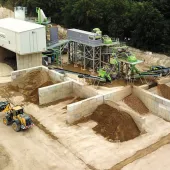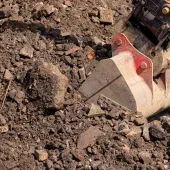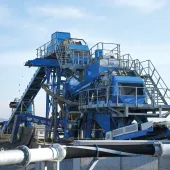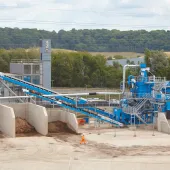New CDE Wash Plant in Barbados
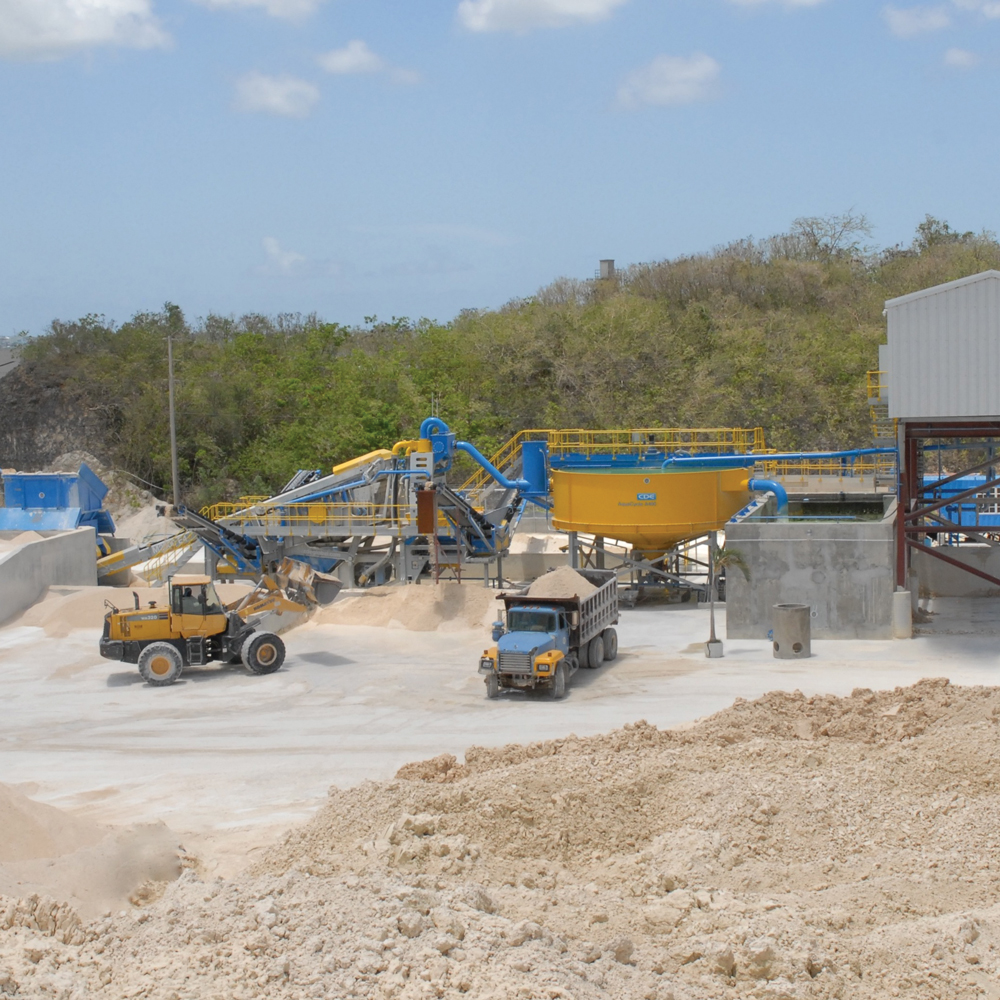
First published in the August 2016 issue of Quarry Management as Creating Value from Waste
Barbados company C.O. Williams invest in new CDE wash plant to process –6mm crusher dust on coral limestone project
CDE have recently commissioned a new wash plant for C.O. Williams to process material from an existing crushing operation at Lears Quarry, near Bridgetown, on the island of Barbados in the eastern Caribbean. As well as operating a 250 tonnes/h crushing plant processing coral limestone that produces more than 35,000 tonnes of aggregates per month, the company also produces more than 18,000 tonnes of asphalt per year.
The crushing plant produces a large quantity of –6mm material with a very high fines content, which is stockpiled on site as a waste product. ‘This waste from the crushing operations was an ongoing concern for us and the high fines content required that we look at a wash plant to see if we could recover any material which could be used either as construction sands or in our own asphalt production,’ explained Neil Weekes, general manager at C.O. Williams.
At the time of writing there were waste stockpiles approaching 500,000 tonnes of the –6mm material waiting to be processed using the CDE wash plant, with the crushing plant producing another 500 tonnes of this material each day.
Analysis of the waste stockpiles revealed a material with 20% –63 micron content. A further sieve analysis revealed that the feed to the sand washing plant (–2.4mm) would contain 36% –63 micron material, necessitating a customized double-pass washing system to ensure this would be reduced to a level that would allow the washed sand products to have a commercial application. The space available on site was limited and access to the volumes of water required to feed a wash plant to do this job satisfactorily was also an issue.
Taking all of this into consideration, CDE designed a project that includes an M2500 mobile washing plant with the required customized dual-pass sand washing system. The plant also includes closed-circuit water recycling with the introduction of an AquaCycle A400 thickener and a side-beam filter press. The final plant footprint measures 45m x 29m and, as a result of the inclusion of the side-beam filter press, has eliminated the requirement for settling ponds.
‘Without the introduction of the AquaCycle thickener and filter press, this project just would not have been possible,’ explained Mr Weekes. ‘The space we had available at Lears Quarry was very restricting and it is only the compact, modular nature of the CDE design that allows us to generate value from the existing waste stockpiles and ensure that in future we are able to deal with the –6mm material from our crushing operations in an efficient manner.’
The new wash plant is producing a range of products which C.O. Williams are using in a number of different applications: a –6mm +2.4mm material is being used in concrete production as is the –2.4mm +63 micron sand product. The –6mm +2.4mm material is also being used in asphalt production. The –1.2mm +63 micron washed sand is used in masonry processes for blockwork and plastering.
The process
The M2500 accepts 100 tonnes/h of crushed coral limestone which is delivered to the top deck of the integrated double-deck rinsing screen. The top deck removes the +6mm material to an oversize stockpile. This represents only 10 tonnes/h (10%) of the feed material. The bottom deck of the screen produces a –6mm +2.4mm material which is also stockpiled via the integrated stockpile conveyor. This product makes up 31 tonnes/h of the feed (31%).
The –2.4mm material is delivered from the screen sump to the first cyclone on the EvoWash sand washing plant. In this first pass the cyclone allows for the efficient removal of the –63 micron material. The –2.4mm +63 micron material is discharged to the split dewatering screen and a –2.4mm +1.2mm mesh sand product is dewatered and stockpiled via the integrated conveyor. This represents 13 tonnes/h of the feed material (13%).
The split screen is set up for the 0–1.2mm material to fall through to the EvoWash sump before being pumped to the second cyclone for a further wash. The second side of the split dewatering screen accepts the cyclone underflow and produces a dewatered –1.2mm +63 micron sand product. This represents 26 tonnes/h of the feed material (26%). A proportion of this product is blended with the –2.4mm +1.2mm sand from the first side of the split dewatering screen to produce a –2.4mm +63 micron product. The dual pass allows for the proportion of –63 micron material in the sand product to be reduced from 36% in the feed to 3% in the final product.
Meanwhile, the overflow from both cyclones delivers the waste water containing the –63 micron material to the AquaCycle thickener. The waste is discharged at the highest point of the EvoWash sand washing plant, which allows for gravity feed to the thickener and eliminates the requirement for an additional sump and pump.
As the waste water enters the thickener tank it is combined with a pre-mixed flocculant from the FlocStation poly plant. This forces all the fine particles to coalesce and sink to the bottom of the tank while the clean water overflows the peripheral weir and is sent to a concrete water storage tank before being recirculated to the wash plant. The AquaCycle is the first stage in the water recycling process and recovers 85% of the process water for reuse.
‘The AquaCycle achieves significant water recycling on its own and without the filter press the waste sludge would then be delivered to on-site settling ponds,’ explained John Gallery, CDE project manager on this project. ‘The space restrictions at the C.O. Williams site necessitated that a further sludge-management stage was introduced as there simply wasn’t the space available to accommodate settling ponds.’
The waste sludge from the AquaCycle thickener is first delivered to a concrete buffer tank before being sent to the side-beam filter press. The filter press has 110 plates and accepts 20 tonnes/h of solids. This is pressed under 15-bar pressure to produce a filter cake with an 80% dry solids content. The water extracted from the sludge at this point is also returned to the water storage tank for recirculation to the wash plant.
The combination of the AquaCycle and side-beam filter press achieves 90% water recycling from the plant and reduces the volume of top-up water required to feed the wash plant to 36m3 per hour. The filter cake is discharged to a bay below the filter-press enclosure which can be accessed by a loading shovel for removal as waste material.
Rapid set-up and a compact footprint
The modular nature of the CDE design was critical with this project as a result of the specific conditions prevailing at Lears Quarry. ‘The space available at the quarry was the stumbling block for us whenever we were exploring a solution to the volume of crushed limestone dust that we were producing,’ explained Mr Weekes. ‘It was only as a result of seeing the CDE equipment at ConExpo in Las Vegas that we started to see a solution to this problem, and the ability to integrate closed-circuit water recycling as part of the plant allowed us to move to a situation where we are now maximizing our product yield from the quarry. Not only does this make our operation more profitable, but it ensures the most efficient extraction and processing of the quarry reserves and makes our operation more sustainable in the long term.’
According to John Gallery of CDE, the modular nature of the processing plant also ensures that process efficiency is maximized. ‘The efficiency of every transfer point within the system further increases the potential for C.O. Williams to maximize product yield and minimize operational costs, which makes for a very compelling return on investment,’ he said. ‘The civils design also allows for the M2500 to be raised by 500mm in order to maximize the stockpile capacity and reduce transport movements on site.’
In addition, the CDE design includes integrated plant walkways which facilitate a complete plant walkthrough for essential plant inspections and maintenance. These make it easy to traverse from the feed point to the filter press, which reduces the time required for plant maintenance and ensures that production time is maximized for C.O. Williams.
An alternative sand source in Barbados
The dominant mineral in Barbados is limestone of the kind processed by C.O. Williams, and according to estimates from the Government of Barbados reserves are in excess of 30 billion tonnes. However, sand is in shorter supply with current extraction focused in the Walkers area on the north-eastern coast. The Government of Barbados website reports that ‘there is only a safe period of about 10 years remaining before adverse effects of the coastline environment occur’. While sand reserves are available in other areas of the island, these are not as easily accessible as they are more siliceous and consolidated.
Taking all of this into account, the development of an alternative sand source from the coral limestone being processed by C.O. Williams represents a way to reduce the pressure on existing sand reserves and provide an alternative sand product for use in construction applications.
‘We recognized not only the business opportunity that existed from the more efficient exploitation of our coral limestone reserve, but also the potential that existed to protect long-term sand and aggregate supply by introducing the advanced processing technologies offered by CDE,’ said Neil Weekes. ‘Our introduction of the AquaCycle thickener and filter-press technology is further evidence of our commitment to building the future for Barbados in a sustainable manner by employing the latest technologies available to us.’
- Subscribe to Quarry Management, the monthly journal for the mineral products industry, to read articles before they appear on Agg-Net.com


